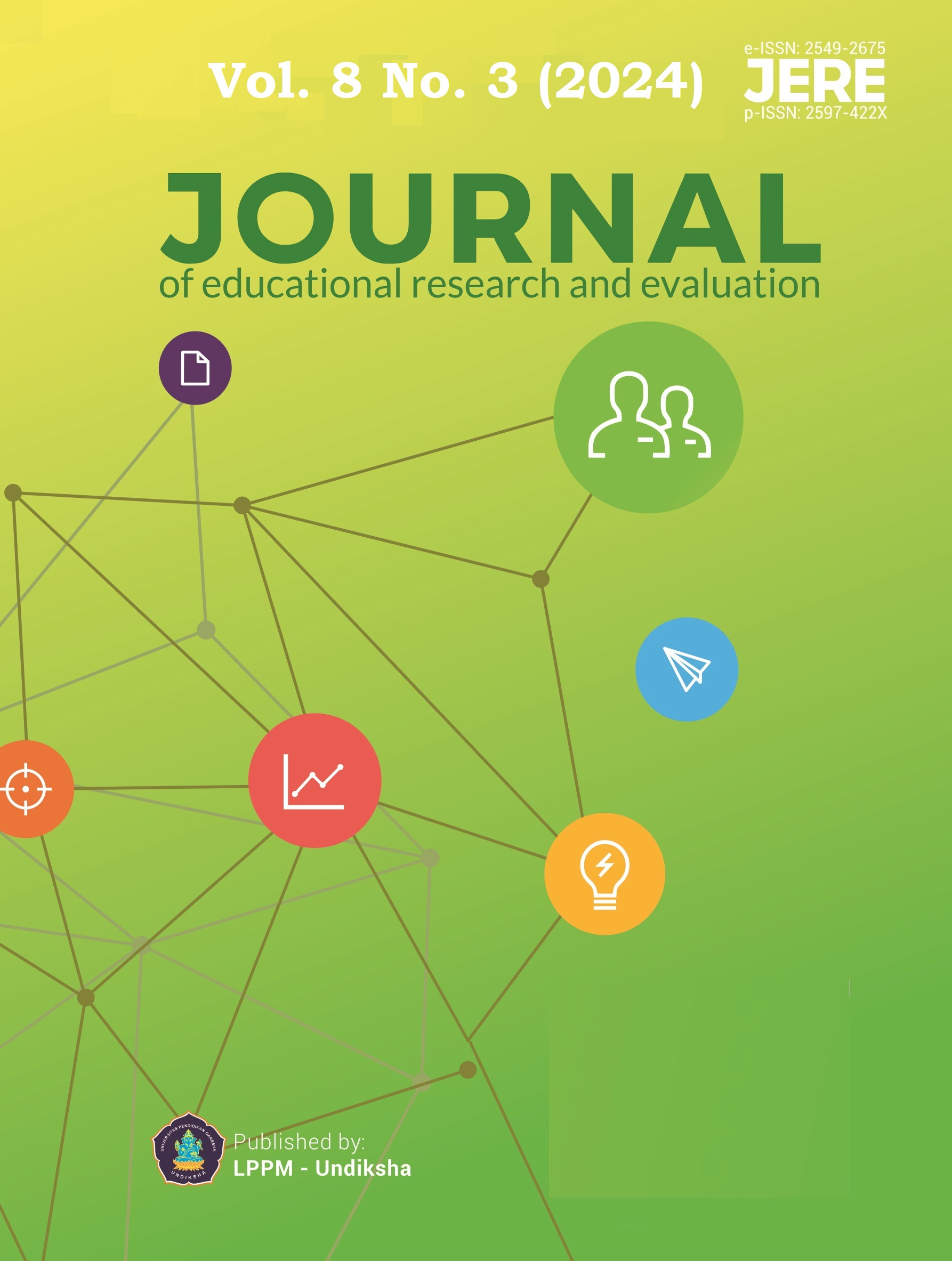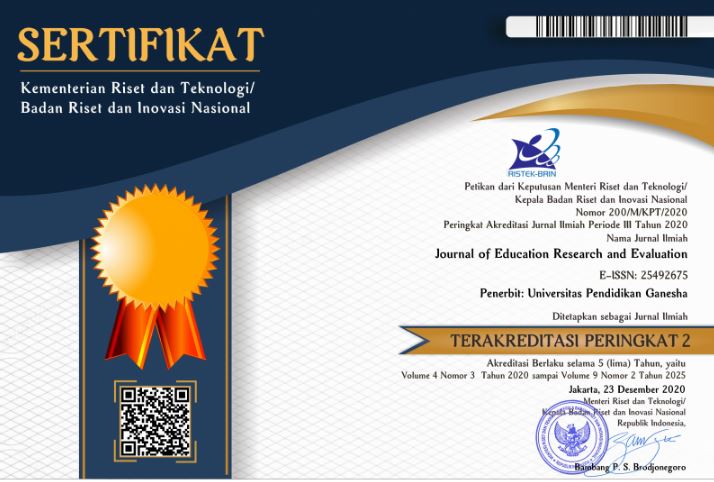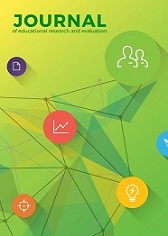The Existence of Digital Literary Criticism and Its Contributions in Preparing Literary Criticism Teaching Materials Post Covid 19 Pandemic
DOI:
https://doi.org/10.23887/jere.v8i3.77676Keywords:
Consistency, Critics, Literature, DigitalAbstract
Literary criticism teaching materials provided on campus only focus on theory and very few opportunities to appreciate literary texts directly through reading and understanding literary criticism published in various sources. Learning literary appreciation, including literary criticism, should not only be about memorizing literary theories, but also through practices such as reading and enjoying literary works directly, as well as appreciating the literary works read. The purpose of this research is to analyze the existence and contribution of digital literary criticism in the preparation of teaching materials for literary criticism. The design used in this research is qualitative. The data analysis technique used is descriptive qualitative through data triangulation. The results of this study show that in the span of one year the average number of literary criticism published in digital media. The data shows that digital literary criticism still exists to provide color in the literary treasury regardless of the dynamics of the ups and downs of the number of literary criticisms published through digital media. Based on the information obtained through the distribution of questionnaires, it is known to contribute to the preparation of teaching materials for literary criticism. Regarding students' interest in digital literary criticism in literary criticism teaching materials, they successfully received a response with a high category. In conclusion, digital literary criticism enriches and expands the scope of teaching materials for literary criticism, making it more dynamic and adaptive to the latest developments in the world of literature and education.
References
Affandi Arianto, M., Saukah, A., Basthomi, Y., & Wulyani, A. N. (2021). Previous studies have several limitations : Indonesian doctoral students’, indonesian academics’, and international authors’ research gap strategies in elt research article abstracts and introductions. Journal of Language and Education, 7(2), 25–44. https://doi.org/10.17323/JLE.2021.11735. DOI: https://doi.org/10.17323/jle.2021.11735
Arbain, A. (2020). Translating Subtitles of Becoming Jane Film: A Pragmatic Approach. Langkawi: Journal of The Association for Arabic and English, 6(1), 17. https://doi.org/10.31332/lkw.v6i1.1766. DOI: https://doi.org/10.31332/lkw.v6i1.1766
Awan, U., Sroufe, R., & Shahbaz, M. (2021). Industry 4.0 and the circular economy: A literature review and recommendations for future research. Business Strategy and the Environment, 30(4), 2038–2060. https://doi.org/10.1002/bse.2731. DOI: https://doi.org/10.1002/bse.2731
Barrinha, A., & Renard, T. (2020). Power and diplomacy in the post-liberal cyberspace. International Affairs, 96(3), 749–766. https://doi.org/10.1093/ia/iiz274. DOI: https://doi.org/10.1093/ia/iiz274
Basilotta-Gómez-Pablos, V., Matarranz, M., Casado-Aranda, L. A., & Otto, A. (2022). Teachers’ digital competencies in higher education: a systematic literature review. International Journal of Educational Technology in Higher Education, 19(1). https://doi.org/10.1186/s41239-021-00312-8. DOI: https://doi.org/10.1186/s41239-021-00312-8
Bilbao-Aiastui, E., Arruti, A., & Morillo, R. C. (2021). A systematic literature review about the level of digital competences defined by DigCompEdu in higher education. Aula Abierta, 50(4), 841–852. https://doi.org/10.17811/RIFIE.50.4.2021.841-850. DOI: https://doi.org/10.17811/rifie.50.4.2021.841-850
Budiharso, T., & Tarman, B. (2020). Improving quality education through better working conditions of academic institutes. Journal of Ethnic and Cultural Studies, 7(1), 99–115. https://doi.org/10.29333/ejecs/306. DOI: https://doi.org/10.29333/ejecs/306
Budiman, A., Samani, M., Rusijono, R., Setyawan, W. H., & Nurdyansyah, N. (2020). The Development of Direct-Contextual Learning: A New Model on Higher Education. International Journal of Higher Education, 10(2), 15. https://doi.org/10.5430/ijhe.v10n2p15. DOI: https://doi.org/10.5430/ijhe.v10n2p15
Bugg, N. (2020). Teaching critical thinking skills. Radiologic Technology, 68(5), 433–434. https://doi.org/10.4324/9780429342042. DOI: https://doi.org/10.4324/9780429342042
Cramer, F., & Jandrić, P. (2021). Postdigital: A Term That Sucks but Is Useful. Postdigital Science and Education, 3(3), 966–989. https://doi.org/10.1007/s42438-021-00225-9. DOI: https://doi.org/10.1007/s42438-021-00225-9
Damono, S. D., Shiddieq, M. R., Patah, S., & Wings, T. B. (2024). A Translation Analysis Of Kahlil Gibran ’ S “ The Broken Wings ” To “ Sayap - Sayap Patah ” By Sapardi Djoko Damono And M . 13(1), 151–164. DOI: https://doi.org/10.26499/rnh.v13i1.4713
Dergaa, I., Chamari, K., Zmijewski, P., & Saad, H. Ben. (2023). From human writing to artificial intelligence generated text: examining the prospects and potential threats of ChatGPT in academic writing. Biology of Sport, 40(2), 615–622. https://doi.org/10.5114/BIOLSPORT.2023.125623. DOI: https://doi.org/10.5114/biolsport.2023.125623
Dobrin, D. (2020). The Hashtag in Digital Activism: A Cultural Revolution. Journal of Cultural Analysis and Social Change, 5(1), 1–14. https://doi.org/10.20897/jcasc/8298. DOI: https://doi.org/10.20897/jcasc/8298
Ebrahimzadeh, S., Rezaei Sharifabadi, S., Karbala Aghaie Kamran, M., & Dalkir, K. (2020). Triggers and strategies related to the collaborative information-seeking behaviour of researchers in ResearchGate. Online Information Review, 44(5), 1077–1096. https://doi.org/10.1108/OIR-12-2019-0380. DOI: https://doi.org/10.1108/OIR-12-2019-0380
Fitriani Lubis, Salmah Naelofaria, & Rumasi Simare-mare. (2020). Analysis of the Requirements for Digital Teaching Materials in Appreciation and Indonesian Literary Criticism Subject in State University of Medan. Britain International of Linguistics Arts and Education (BIoLAE) Journal, 2(2), 598–603. https://doi.org/10.33258/biolae.v2i2.274. DOI: https://doi.org/10.33258/biolae.v2i2.274
Fridayani, H. D., & Soong, J. J. (2021). The Emergent Role of Local Government On Covid-19 Outbreak In Indonesia: A New State-Society Perspective. Journal of Governance, 6(1). https://doi.org/10.31506/jog.v6i1.10287. DOI: https://doi.org/10.31506/jog.v6i1.10287
Furenes, M. I., Kucirkova, N., & Bus, A. G. (2021). A Comparison of Children’s Reading on Paper Versus Screen: A Meta-Analysis. In Review of Educational Research (Vol. 91, Issue 4). https://doi.org/10.3102/0034654321998074. DOI: https://doi.org/10.3102/0034654321998074
García-Peñalvo, F. J. (2022). Developing robust state-of-the-art reports: Systematic Literature Reviews. Education in the Knowledge Society, 23, E28600. https://doi.org/10.14201/eks.28600. DOI: https://doi.org/10.14201/eks.28600
Hakim, R., Ritonga, M., & Susanti, W. (2020). Implementation of Contextual Teaching and Learning in Islamic Education at Madrasah Diniyah. Jour of Adv Research in Dynamical & Conrol Systems, 12(02), 3326–3332. https://doi.org/10.5373/JARDCS/V12I2/S20201455.
Hollstein, B., & Rosa, H. (2023). Social Acceleration: A Challenge for Companies? Insights for Business Ethics from Resonance Theory. Journal of Business Ethics, 188(4), 709–723. https://doi.org/10.1007/s10551-023-05506-w. DOI: https://doi.org/10.1007/s10551-023-05506-w
Humprecht, E., Herrero, L. C., Blassnig, S., Brüggemann, M., & Engesser, S. (2022). Media Systems in the Digital Age: An Empirical Comparison of 30 Countries. Journal of Communication, 72(2), 145–164. https://doi.org/10.1093/joc/jqab054. DOI: https://doi.org/10.1093/joc/jqab054
Hutagalung, T. B. (2021). Locations of Theological Anthropology in Indonesia: A Postcolonial Literary Offer in Max Havelaar. Indonesian Journal of Theology, 9(1), 93–124. DOI: https://doi.org/10.46567/ijt.v9i1.190
Hutauruk, M., & Puspita, D. (2020). a Metapragmatic Analysis: a Study of Pragmatic Failure Found in Indonesian Efl Students. Linguistics and Literature Journal, 1(2), 62–69. https://doi.org/10.33365/llj.v1i2.589. DOI: https://doi.org/10.33365/llj.v1i2.589
Jameson, F. (1986). Third-World Literature in the Era of Multinational Capitalism. Social Text, 15, 65. https://doi.org/10.2307/466493. DOI: https://doi.org/10.2307/466493
Kaminski, J. A., & Sloutsky, V. M. (2020). The use and effectiveness of colorful, contextualized, student-made material for elementary mathematics instruction. International Journal of STEM Education, 7(1). https://doi.org/10.1186/s40594-019-0199-7. DOI: https://doi.org/10.1186/s40594-019-0199-7
Karnouskos, S. (2020). Artificial Intelligence in Digital Media: The Era of Deepfakes. IEEE Transactions on Technology and Society, 1(3), 138–147. https://doi.org/10.1109/tts.2020.3001312. DOI: https://doi.org/10.1109/TTS.2020.3001312
Lim, W. M., Kumar, S., & Ali, F. (2022). Advancing knowledge through literature reviews: ‘what’, ‘why’, and ‘how to contribute.’ Service Industries Journal, 42(7–8), 481–513. https://doi.org/10.1080/02642069.2022.2047941. DOI: https://doi.org/10.1080/02642069.2022.2047941
Linkis, S. T. (2020). Resonant Listening: Reading Voices and Places in Born-Audio Literary Narratives. Canadian Review of Comparative Literature, 47(4), 407–423. https://doi.org/10.1353/CRC.2020.0037. DOI: https://doi.org/10.1353/crc.2020.0037
Madison, N., & Klang, M. (2020). the Case for Digital Activism: Refuting the Fallacies of Slacktivism. Journal of Digital Social Research, 2(2), 28–47. https://doi.org/10.33621/jdsr.v2i2.25. DOI: https://doi.org/10.33621/jdsr.v2i2.25
Mardiani, & Baharuddin, A. F. (2023). Literature-Based Efl Instruction: Benefits for Language Skills Development, Learning Motivation, and Cultural Understanding. LLT Journal: Journal on Language and Language Teaching, 26(2), 796–811. https://doi.org/10.24071/llt.v26i2.6366. DOI: https://doi.org/10.24071/llt.v26i2.6366
Masschelein, A. (2021). Introduction: Literary Advice from Quill to Keyboard. In New Directions in Book History. Springer International Publishing. https://doi.org/10.1007/978-3-030-53614-5_1. DOI: https://doi.org/10.1007/978-3-030-53614-5_1
Mühlhoff, R. (2020). Human-aided artificial intelligence: Or, how to run large computations in human brains? Toward a media sociology of machine learning. New Media and Society, 22(10), 1868–1884. https://doi.org/10.1177/1461444819885334. DOI: https://doi.org/10.1177/1461444819885334
Mustofa, A., & Lestari, L. A. (2023). Literary Criticism in the Digital Age: Addressing the Problems and Opportunities of Digital Literature in Efl Pedagogy. English Review: Journal of English Education, 11(1), 263–274. https://doi.org/10.25134/erjee.v11i1.7137. DOI: https://doi.org/10.25134/erjee.v11i1.7137
Mystakidis, S., Berki, E., & Valtanen, J. P. (2021). Deep and meaningful e-learning with social virtual reality environments in higher education: A systematic literature review. Applied Sciences (Switzerland), 11(5). https://doi.org/10.3390/app11052412. DOI: https://doi.org/10.3390/app11052412
Olave, T., & Sociology, C. (2022). Edinburgh Research Explorer Reading matters. 6(3), 417–454.
Padilla-Rivera, A., Russo-Garrido, S., & Merveille, N. (2020). Addressing the social aspects of a circular economy: A systematic literature review. Sustainability (Switzerland), 12(19), 1–17. https://doi.org/10.3390/SU12197912. DOI: https://doi.org/10.3390/su12197912
Pangrazio, L., Godhe, A. L., & Ledesma, A. G. L. (2020). What is digital literacy? A comparative review of publications across three language contexts. E-Learning and Digital Media, 17(6), 442–459. https://doi.org/10.1177/2042753020946291. DOI: https://doi.org/10.1177/2042753020946291
Pawlicka, A., Choraś, M., & Pawlicki, M. (2021). The stray sheep of cyberspace a.k.a. the actors who claim they break the law for the greater good. Personal and Ubiquitous Computing, 25(5), 843–852. https://doi.org/10.1007/s00779-021-01568-7. DOI: https://doi.org/10.1007/s00779-021-01568-7
Petrovych, O. B., Vinnichuk, A. P., Krupka, V. P., Zelenenka, I. A., & Voznyak, A. V. (2021). The usage of augmented reality technologies in professional training of future teachers of Ukrainian language and literature. CEUR Workshop Proceedings, 2898, 315–333. DOI: https://doi.org/10.31812/123456789/4635
Plyth, P. S. (2020). Translation affects literary and cultural systems: how to observe the features of translation? Applied Translation. https://doi.org/10.51708/apptrans.v14n1.1141. DOI: https://doi.org/10.51708/apptrans.v14n1.1141
Priyono, A., Moin, A., & Putri, V. N. A. O. (2020). Identifying digital transformation paths in the business model of smes during the covid-19 pandemic. Journal of Open Innovation: Technology, Market, and Complexity, 6(4), 1–22. https://doi.org/10.3390/joitmc6040104. DOI: https://doi.org/10.3390/joitmc6040104
Rebora, S., Boot, P., Pianzola, F., Gasser, B., Herrmann, J. B., Kraxenberger, M., Kuijpers, M. M., Lauer, G., Lendvai, P., Messerli, T. C., & Sorrentino, P. (2021). Digital humanities and digital social reading. Digital Scholarship in the Humanities, 36, II230–II250. https://doi.org/10.1093/llc/fqab020. DOI: https://doi.org/10.1093/llc/fqab020
Rinekso, A. B., Rodliyah, R. S., & Pertiwi, I. (2021). Digital literacy practices in tertiary education: A case of efl postgraduate students. Studies in English Language and Education, 8(2), 622–641. https://doi.org/10.24815/siele.v8i2.18863. DOI: https://doi.org/10.24815/siele.v8i2.18863
Rodríguez-Abitia, G., Martínez-Pérez, S., Ramirez-Montoya, M. S., & Lopez-Caudana, E. (2020). Digital gap in universities and challenges for quality education: A diagnostic study in Mexico and Spain. Sustainability (Switzerland), 12(21), 1–14. https://doi.org/10.3390/su12219069. DOI: https://doi.org/10.3390/su12219069
Sambayon, J. T., Luceñara, D. P., Luceñara, C. P., Bayron, Q. M., Peñaloga, R. A., & Larombe, E. A. (2023). Effectiveness Of Contextualized Learning Materials In Improving The Reading Skills And Comprehension Level Of The Students Psychology And Education: A Multidisciplinary Journal Effectiveness of Contextualized Learning Materials in Improving the Reading Skills and Comprehension Level of the Students. Psych Educ, 7, 2023–2564. https://doi.org/10.5281/zenodo.7702258.
Schwabe, A., Brandl, L., Boomgaarden, H. G., & Stocker, G. (2021). Experiencing literature on the e-reader: the effects of reading narrative texts on screen. Journal of Research in Reading, 44(2), 319–338. https://doi.org/10.1111/1467-9817.12337. DOI: https://doi.org/10.1111/1467-9817.12337
Siraj, F. M., Arif, R., Syadli, M., & Amril. (2022). the Existence and the Challenges of Sufi Literature in Indonesia. Afkar, 24(1), 243–270. https://doi.org/10.22452/afkar.vol24no1.7. DOI: https://doi.org/10.22452/afkar.vol24no1.7
Sohayle M. Hadji Abdul Racman, R. A. L. (2019). Journal of Communication and Cultural Trends (JCCT). Journal of Communication and Cultural Trends (JCCT), 1(2, Fall 2019), 18–26. DOI: https://doi.org/10.32350/jcct.11.02
Tenda, E. D., Asaf, M. M., Pradipta, A., Kumaheri, M. A., & Susanto, A. P. (2021). Surge in Indonesia. Breath, 17(4), 1–5. https://doi.org/10.1183/20734735.0146-2021. DOI: https://doi.org/10.1183/20734735.0146-2021
Tolibova, N. N., & Pulatova, S. K. (2021). the Concept of Transl the Concept of Translation and Pra Tion and Pragmatics. Scientific Reports of Bukhara State University, 5(1), 101–111. https://doi.org/10.52297/2181-1466/2021/5/1/8. DOI: https://doi.org/10.52297/2181-1466/2021/5/1/8
Type, M., Keywords, I. P., & Jsma-, M. I. D. (2021). u Jo te gy an d M an e ag m en t u Jo rn of St ra te gy an d M e m t.
Tyson, L. (2020). Using critical theory: How to read and write about literature. In Using Critical Theory: How to Read and Write About Literature. https://doi.org/10.4324/9780429469022. DOI: https://doi.org/10.4324/9780429469022
U.N, K. (2020). The Issue of Spiritual and Patriotic Education of Young Generation in the Scientific, Political and Literary Heritage of Central Asian Thinkers. International Journal of Psychosocial Rehabilitation, 24(5), 6694–6701. https://doi.org/10.37200/ijpr/v24i5/pr2020657. DOI: https://doi.org/10.37200/IJPR/V24I5/PR2020657
Uri, D., & Coiro, J. (2020). College of Education Faculty Publications Toward a Multifaceted Heuristic of Digital Reading to Inform Assessment , Research , Practice , and Policy Toward a Multifaceted Heuristic of Digital Reading to Inform Assessment ,. College of Education Faculty Publications, 1–71. https://digitalcommons.uri.edu/education_facpubs/21. DOI: https://doi.org/10.1002/rrq.302
Usman, H., & Anwar, M. (2021). Integrated language skill approach: Model of teaching materials for elementary school teacher education programs in indonesia. Studies in English Language and Education, 8(2), 656–669. https://doi.org/10.24815/siele.v8i2.19031. DOI: https://doi.org/10.24815/siele.v8i2.19031
Wananga. (2023). A Thesis Submitted in Fulfilment of the Requirements for the Degree. Angewandte Chemie International Edition, 6(11), 951–952., 1(April).
Wieringa, E. P. (2020). Mother ’ s tongue and father ’ s culture. V, 384–407. https://doi.org/10.17510/wacana.v21i3.945.Edwin.
Wieringa, E. P. (2021). Mother’s tongue and father’s culture: A late nineteenth-century Javanese versification of Master Zhu’s Household Rules (Zhuzi Zhijia geyan). Wacana, 21(3), 384–407. https://doi.org/10.17510/WACANA.V21I3.945. DOI: https://doi.org/10.17510/wacana.v21i3.945
Xiao, F., Wang, Z., & He, D. (2020). Understanding users’ accessing behaviors to local Open Government Data via transaction log analysis. Proceedings of the Association for Information Science and Technology, 57(1), 1–14. https://doi.org/10.1002/pra2.278. DOI: https://doi.org/10.1002/pra2.278
Zein, S., Sukyadi, D., Hamied, F. A., & Lengkanawati, N. S. (2020). English language education in Indonesia: A review of research (2011-2019). Language Teaching, 53(4), 491–523. https://doi.org/10.1017/S0261444820000208. DOI: https://doi.org/10.1017/S0261444820000208
Zhang, P. (2023). New Media, New Literary Theory, and New Literature from an Interological Horizon. Signs and Media, 2(1–2), 1–22. https://doi.org/10.1163/25900323-12340020. DOI: https://doi.org/10.1163/25900323-12340020
Іванюк, І. В., & Овчарук, О. В. (2020). the Response of Ukrainian Teachers To Сovid-19: Challenges and Needs in the Use of Digital Tools for Distance Learning. Information Technologies and Learning Tools, 77(3), 282–291. https://doi.org/10.33407/itlt.v77i3.3952. DOI: https://doi.org/10.33407/itlt.v77i3.3952
Downloads
Published
How to Cite
Issue
Section
License
Copyright (c) 2024 Dewa Gede Bambang Erawan, Putu Devi Maharani, Ni Wayan Suastini, Ida Ayu Made Wedasuwari, Luh Putri Pramesti Artayani, I Komang Asmara Utama

This work is licensed under a Creative Commons Attribution-ShareAlike 4.0 International License.
Authors who publish with the Journal of Evaluation and Research in Education (JERE) agree to the following terms:
- Authors retain copyright and grant the journal the right of first publication with the work simultaneously licensed under a Creative Commons Attribution License (CC BY-SA 4.0) that allows others to share the work with an acknowledgment of the work's authorship and initial publication in this journal.
- Authors are able to enter into separate, additional contractual arrangements for the non-exclusive distribution of the journal's published version of the work (e.g., post it to an institutional repository or publish it in a book), with an acknowledgment of its initial publication in this journal.
- Authors are permitted and encouraged to post their work online (e.g., in institutional repositories or on their website) prior to and during the submission process, as it can lead to productive exchanges, as well as earlier and greater citation of published work. (See The Effect of Open Access)











